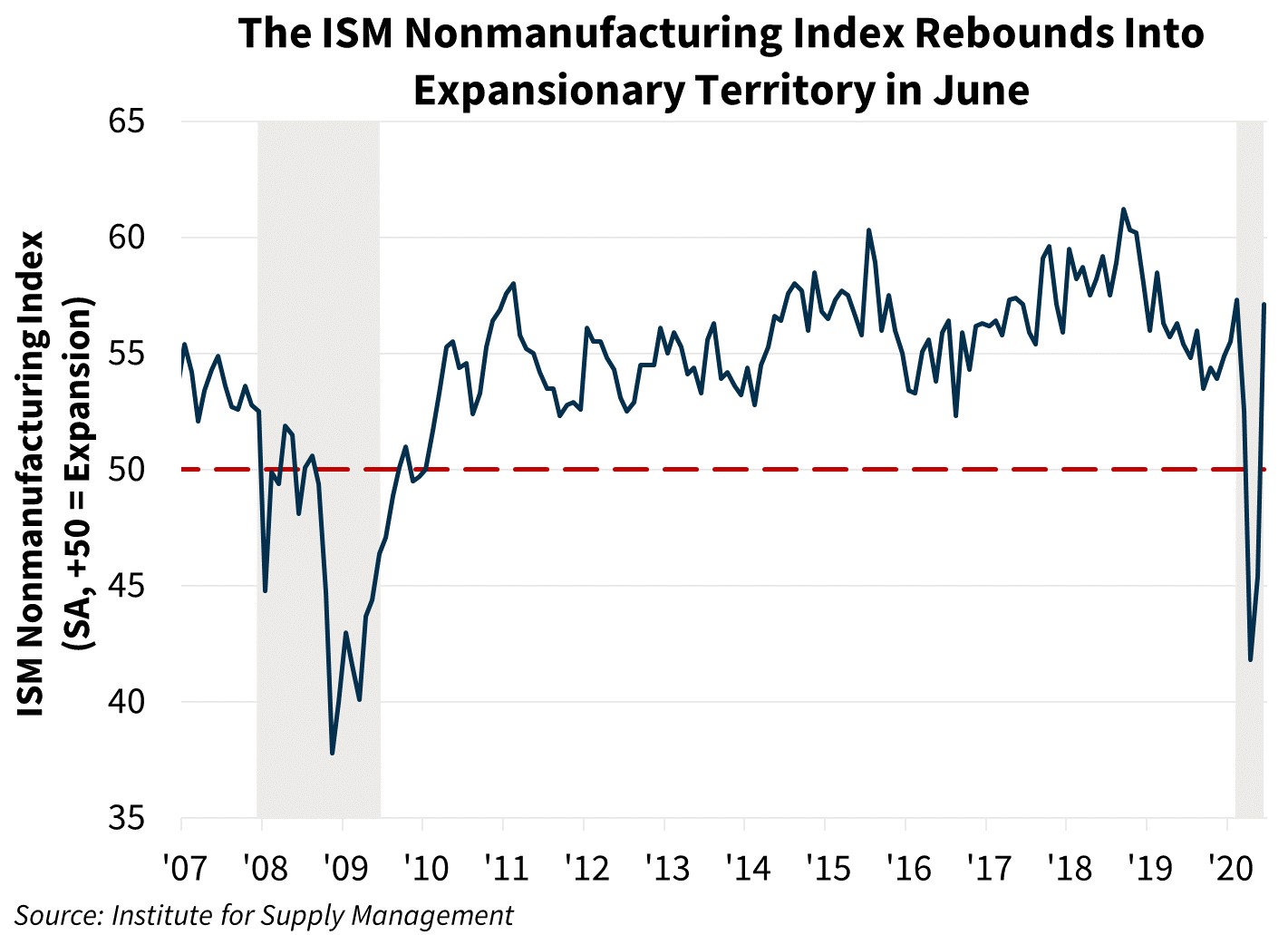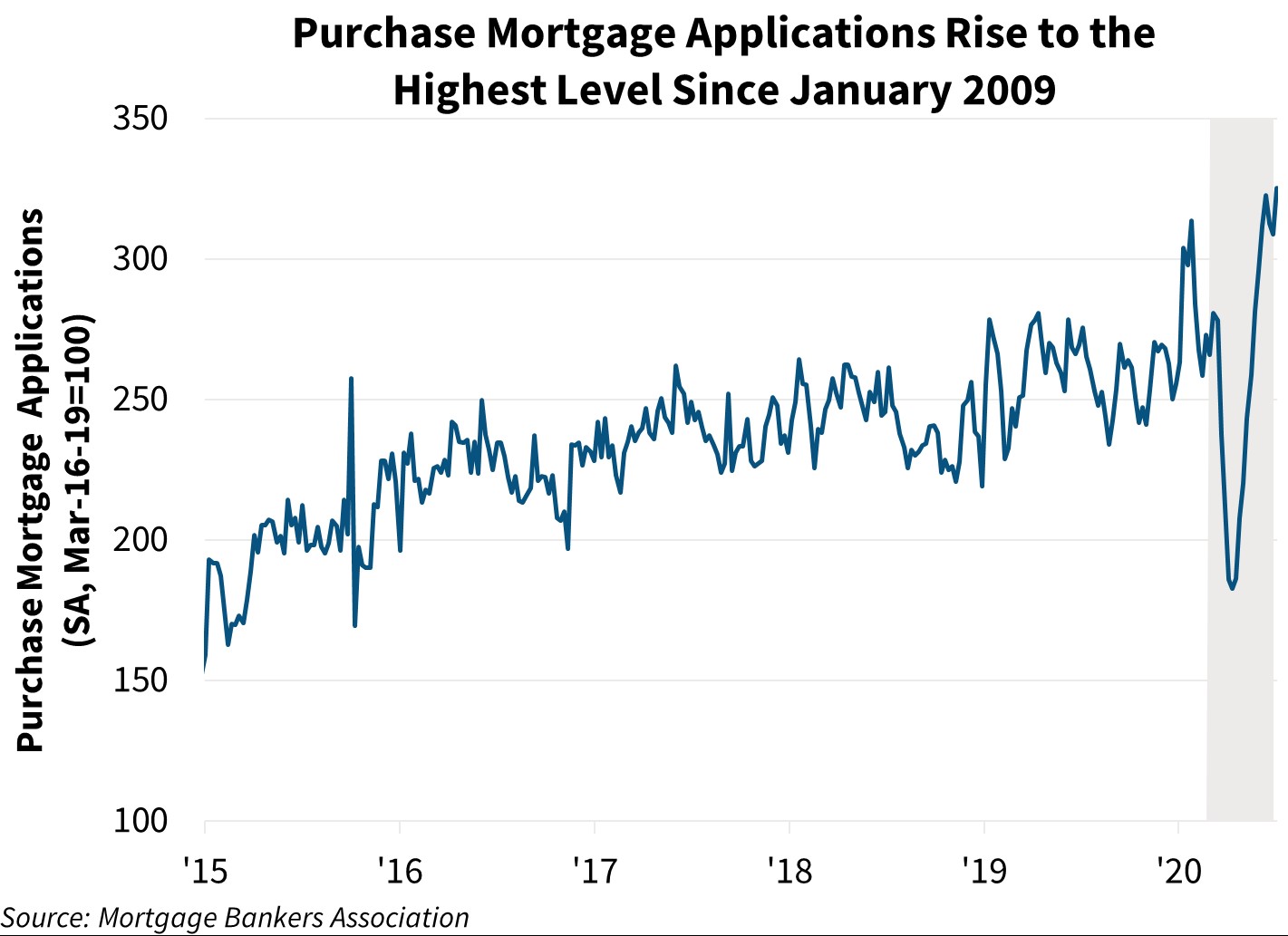Service Sector Returns to Expansionary Territory
Key Takeaways:
- The ISM Nonmanufacturing Index, a gauge of service sector activity, jumped 11.7 points in June to 57.1. This was just below the reading seen in February and the largest increase since the series began in 1997. Any reading above 50 indicates expansion. The historic increase was driven by record increases in the business activity, new orders, and employment indices, though the employment index remained below the 50-point threshold.
- Consumer (non-mortgage) credit outstanding dropped by approximately $18.3 billion in May, according to the Federal Reserve Board, the third straight month of decline. The decline was driven entirely by revolving credit (largely credit cards) which fell by $24.3 billion, following the record decline in April, while nonrevolving credit (largely student and auto loans) increased by $6.0 billion.
- The Job Openings and Labor Turnover Survey (JOLTS) showed that job openings rose by 401,000 in May, according to the Bureau of Labor Statistics, though remain 22.9 percent lower than they were in February. Total hires jumped by 2.4 million to 6.5 million, while total separations fell by 5.8 million to 4.2 million. The increase in job openings was driven by an increase of openings in the leisure/hospitality and retail trade industries as those industries began reopening in earnest. The increase in hires was also driven by the leisure/hospitality industry, as well as strong increases in education/health services and construction.
- The CoreLogic National House Price Index, a repeat sales measure, rose 0.7 percent in May (not seasonally adjusted). From a year ago, the index rose 4.8 percent, the fastest annual pace of growth since November 2018.
- Mortgage applications rose 2.2 percent for the week ending July 3, according to the Mortgage Bankers Association. Purchase applications grew 5.3 percent to the highest level since January 2009. Refinance applications edged up 0.4 percent. From a year ago, purchase and refinance applications were up 18.0 percent and 87.5 percent, respectively.
Forecast Impact
The jump into expansionary territory in the ISM Nonmanufacturing Index highlights the resurgence of activity as businesses and states reopen, and supports our expectation of a rebound in consumer spending and overall economic growth in the coming months. Data from May continues to show the effects of the virus and shutdowns on economic activity, with revolving consumer credit falling for the third straight month as consumers pulled back from spending due to both infection avoidance behaviors and as the shutdown of many businesses made it difficult to spend. However, we expect this means that there will be pent-up demand going forward, and the data may show an increase in revolving credit in June as consumers become more willing to go out and spend. While employment data this week is lagged, it continues to show that a large portion of the recent recovery in employment is being driven by workers in the leisure/hospitality sector returning to work. However, despite the May increase in hires, overall payroll employment in May was still 12.7 percent lower than in February. Also, the hires seen in May were in riskier industries that primarily rely on person-to-person interactions, and thus are also at the most risk of further shutdowns and layoffs given the recent rise in cases across much of the country. While employment data this week is lagged, it continues to show that a large chunk of the recent recovery in employment is being driven by workers in the leisure/hospitality sector returning to work. However, most of the job openings are also located in these riskier categories, as well. In housing, despite recent economic turmoil, home price appreciation remained strong in May due to a dearth of available for-sale supply, along with persistently strong purchase demand. Purchase demand has shown few signs of fading, with the most recent MBA report showing that purchase mortgage applications rose to their highest level since the beginning of 2009. The continued strength in purchase demand will likely lead us to increase our near-term expectations for home sales.


Economic and Strategic Research Group
July 10, 2020
Opinions, analyses, estimates, forecasts and other views of Fannie Mae's Economic and Strategic Research (ESR) Group included in these materials should not be construed as indicating Fannie Mae's business prospects or expected results, are based on a number of assumptions, and are subject to change without notice. How this information affects Fannie Mae will depend on many factors. Although the ESR group bases its opinions, analyses, estimates, forecasts and other views on information it considers reliable, it does not guarantee that the information provided in these materials is accurate, current or suitable for any particular purpose. Changes in the assumptions or the information underlying these views, including assumptions about the duration and magnitude of shutdowns and social distancing, could produce materially different results. The analyses, opinions, estimates, forecasts and other views published by the ESR group represent the views of that group as of the date indicated and do not necessarily represent the views of Fannie Mae or its management.
